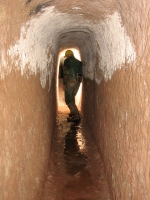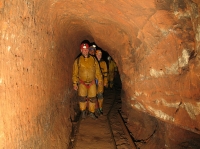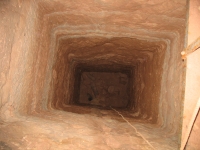Where am I? DCC > ALDERLEY EDGE > HISTORY > PASSAGE TYPES
ALDERLEY EDGE MINE PASSAGE TYPES
One of the issues with exploring and recording abandoned mines is the dating of mines or even individual parts of the mine. On rare occasions, the miner might have left a date such as the examples below from Brynlow Mine (1764 and 1866) and Reeking Mine (1862).



But even this evidence is not conclusive, JW and GL are close together in Brynlow. What if JW found this open passage rather than excavating it? What if JW had never marked the wall at all then we might think GL excavated it? The example of CEM at Reeking Mine is probably the only one we can be convinced by. On other occasions, we might have documentary evidence of the workings. For example, we know that what is now known as the Hough Level was driven around 1862 to connect Engine Vein to the works. But while we know that mining was taking place between 1693 and 1697 (see Chronology), we do not know which mines were being worked and can only guess at Engine Vein because winches were in use.
Looking at the mine passages combined with other evidence found in them gives a system for assessing the age. It will not be accurate or totally reliable but experience tells that a reasonable assessment of age can be made this way. Referring to the pictures below, these are the main characteristics of each period:
1 BRONZE AGE (2000 BCE - 1750 BCE): Open to surface at Alderley (Great Orme, for example, has extensive underground workings). The walls will be smooth with no signs of sharp tools. It is likely that firesetting and use of hammerstones provided the main method of mining. The two pictures show Bronze Age workings in half-section. They have been identified as Bronze Age by form and by tools found in the vicinity.
2 ROMAN MINING (43 CE - c.100 CE): Mining underground using a shaft offset from the workings so as to protect the integrity of the shaft. The passage shape is fairly rectangular with a slight slope on the roof from side to side and having a good working height. Tool marks are regular and show use of sweeping pick movements with a sharp tool. The only clearly identified Roman shaft and passage at Alderley Edge is in Engine Vein. Note that the shaft is square but with a slight rotation (anti-clockwise looking down) whereas later shafts are usually rectangular. The mine is question was identified as Roman because a hoard of later Roman coins was found at the top. However, it could be iron age although this is unlikely given the "professionalism" of the mining.
3 MEDIAEVAL AND LATER (400 CE - 1693 CE): There are no passages that have been identified to this period. However, evidence elsewhere suggests that they would probably have been similar to the passages in the next period.
4 LATE 17th - 18th CENTURY (1693 CE - c. 1800): There are at least three periods of mining at Alderley Edge in this timeslot but it appears that the passage type did not change much during this period. The miners were pursuing the "veins" so workings tended to be narrow and access tunnels to the working area were as small as possible. The period includes the driving of the Hough Level from below Stormy Point to Engine Vein for drainage purposes. Although the workings show only the use of pick marks on the walls, Brynlow Adit (probably around 1760 CE) has a small shothole in the middle of the forefield. A single shot probably loosened material which was then picked out by hand. In the illustrations below, the coffin levels at Brynlow and Square Shaft are typical access tunnels. Workings took the form of the vein working as in Engine Vein using the fault wall as one side of the excavation and timbers to form roofs and floors where necessary. Shafts, such as Square Shaft, are generally rectangular with foot holes or stemple holes in the long sides. The last picture from this period shows the Hough Level between Engine Vein and the Dickens Wood exit where the coffin level from this period has been enlarged to form a tramming level.
5 EARLY 19th CENTURY (1805 CE - 1815 CE): The precise history of this period is unclear but it looks as if the miners were looking for copper and lead and then found the cobalt rich mineral which was exploited in a series of mines on a roughly north-south alignment. Exploratory and access passages are larger than the coffin levels and have a rounded roof. The walls taper slightly towards the floor. Working is mainly by use of picks but explosives cannot be ruled out and might have been used in the same way as in the previous mining period. Shafts are often circular which might be a sign of employment of local well-sinkers as miners. The large shaft in Engine Vein - Bear Pit - was made oval which is almost certainly a sign that it was a hauling shaft (two buckets, passing each other half way down the shaft). There are not many sites that could be classed as stoped-out areas but in the Cobalt Mine, these take the form of "flats" rather than vein-type excavations. Apart from the cobalt output, it appears that little of commercial value was mined at Alderley in this period.
6 MID TO LATE 19th CENTURY (1858 CE - 1878 CE): This is the best recorded period and was also when explosives were used extensively as the chief ore mined was the copper-rich sandstone rather than primary ores on the "veins". The explosive used was black powder and drill holes were triangular and drilled by hand. These are distinctive for this period. Access tunnels were generally of good size as mining was quicker with explosives so the adit at Wood Mine is a good example. Stopes ranged from modest to huge as shown in the pictures of West Mine where barren rock was removed between the beds of ore. Shafts were generally roughly circular or oval). Circular shafts as in the upwards shaft in Wood Mine were often used for ventilation. Some shafts such as Chain Shaft in West mine provided an ore tipping route separated by a timber brattice from a climbing way. One notable shaft in Wood Mine was excavated downwards which may explain its rectangular shape as explosives would be less effective in driving such a shaft. In one of the West Mine pictures, the shape clearly shows a narrow pilot drive in the roof. This can be followed for some distance through the mine and has all the hallmarks of being from the early 19th century period when the copper-rich sandstone did not provide a viable ore. Not all passages were driven using mainly explosives; where the ground was soft (Doc Mine lower level and Hough Level from Engine Vein to Dicken's Wood), the signs point to use of very little black powder and a lot of picking. In the Hough Level, we think that rotary hand-drills and plug-and-feather might have been used as the passage was being enlarged and there are notches in one wall at regular intervals.
7 EARLY 20th CENTURY (1911 CE - 1919 CE): The mines were worked sporadically in this period. West and Wood Mines were re-equipped with tramways and levels were driven in West Mine. There is some evidence of removing rich copper and lead deposits from the walls in Wood Mine and a short trial section was driven off Sand Cavern in Wood Mine. These tunnels were driven using high explosives, probably dynamite, and the evidence is in the lack of clear drill marks as the explosive shattered the rock around the drill hole. There is no evidence of electricity or compressed air being used in the mines so drilling was probably by hand.
Go to TOP
PHOTOGRAPHS
click a picture below to enlarge it
Go to TOP


























